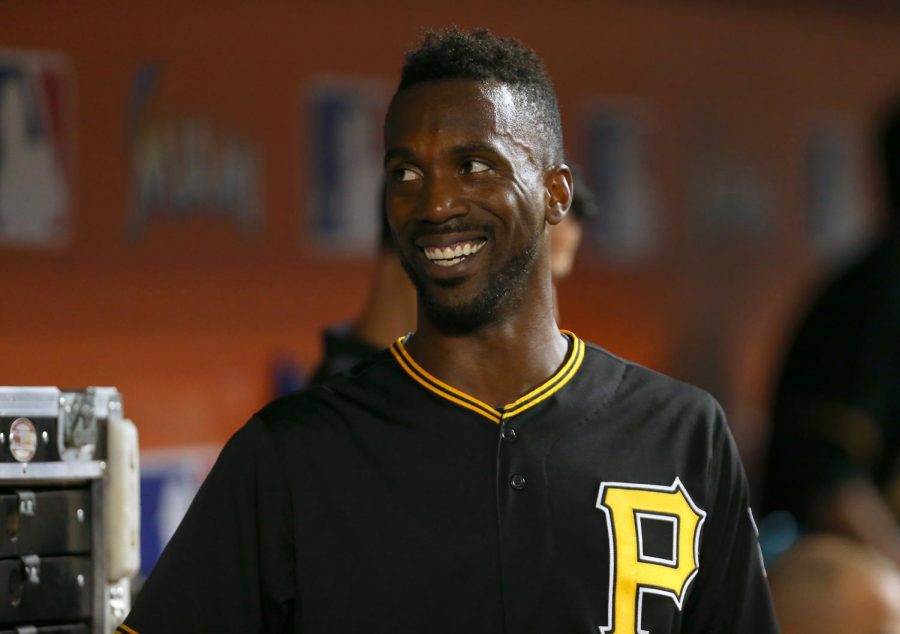Column | Pirates downfall starts at the top
David Santiago | El Nuevo Herald, TNS
The Pittsburgh Pirates’ Andrew McCutchen shown on Aug. 26, 2015, at Marlins Park in Miami.
March 5, 2021
In the only major sports league without a salary cap, money is king. A growing gap exists in Major League Baseball between the highest and lowest payroll teams, and with that, a lack of parity. For the small-market teams, when the window to build a contender comes along, management and ownership must act quickly.
The Pittsburgh Pirates’ downfall came at the hands of the perfect storm — an owner that wouldn’t spend the money to stay competitive, while player contracts only got more lucrative due to the evolving league.
The 2013 NL Wild Card game marked the turnaround of a franchise and fanbase after two tumultuous decades of irrelevance. The Pittsburgh Pirates had finished the season at 94-68 — securing their first season above .500 since 1992. The season gave a generation of fans a glimpse of what postseason baseball looked like in western Pennsylvania.
That team would later fall to the eventual NL-champion St. Louis Cardinals in five games in the NLDS. While that put a disappointing end to an otherwise memorable season, the Pirates saw a light at the end of a previously endless tunnel for the first time in more than two decades.
A roster that consisted of reigning NL MVP Andrew McCutchen, young ace Gerrit Cole and one of the best bullpens in baseball seemed like a lock to return to contention for a World Series. The days of perpetual disappointment in the Steel City were seemingly over. Instead, the McCutchen-era Pirates saw just two more playoff games before fading back into anonymity.
Seven years later, the Pirates finished the COVID-shortened 2020 season with a putrid record of 19-41. Just five years after hosting a 98-win team, baseball in Pittsburgh had once again been reduced to a rubbled wasteland. What happened?
The Pirates downturn following the 2015 season started at the top — specifically with majority owner Bob Nutting and general manager Neal Huntington.
Plenty of tough decisions had to be made after the Pirates 2015 season. The pitching staff needed a closer look, with key trade deadline acquisition J.A. Happ due for a new contract and fellow starter A.J. Burnett mulling retirement.
This dilemma presented a fork in the road for the franchise. Nutting could either choose to open his pocketbook to set the team up for long-term success or go back to the old ways of accepting mediocrity in the name of profit.
The billionaire chose the latter.
Happ would leave for Toronto, and with the retirement of Burnett, the Pirates traded Pittsburgh native and fan-favorite starting second baseman Neil Walker to the Mets in exchange for Jon Neise, who posted an underwhelming 4.13 ERA in the season prior. The Pirates also signed 38-year-old Ryan Vogelsong, a shell of his former self.
This trend of management choosing to save money over quality adjustments ultimately doomed the Pirates. As the ship began to sink, management let water fill the hull.
Small-market teams have a bit of an uphill battle when it comes to remaining in contention after a few years of sustained success, like what the Pirates saw from 2013 to 2015. Since baseball is the only major sport without a salary cap, teams with wealthy owners have the inside track to signing big-name free agents to lucrative deals.
These teams come swooping in as soon as the small-market players hit free agency, offering exorbitant contracts to players who have often never seen that kind of money. Not to say that small-market teams cannot survive at the mountaintop, but they have to get creative.
One example is the Tampa Bay Rays, a frequent trading partner of the Pirates, which has rolled out an exciting and talented team for years without breaking the bank. They do so through player development, smart contracts, cerebral trading and ownership that will dip its toe into the free-agent market when it sees fit.
The Rays will hang a second AL Pennant in less than 13 years at the start of the upcoming season. This is the model that the Pirates need to follow.
Three players lifted the Rays to the best record in the AL and a World Series berth last season — pitchers Tyler Glasnow and Charlie Morton and outfielder Austin Meadows — three former Pirates failed by the team’s ineptitude.
Morton spent years trying to find consistent success in Pittsburgh. He showed glimpses of potential stardom, but the front office eventually pulled the plug on him, appearing to see him as nothing more than dead weight. After the Pirates finally set Morton free, the pitcher saw a career resurgence at age 33 with the Houston Astros. In his five seasons since departing Pittsburgh, Morton played in two World Series, winning one — of which he recorded the final out — and is still regarded as one of the best arms in baseball.
Pittsburgh traded Meadows and Glasnow to Tampa in a misguided attempt by Pirates ownership to appease the fans asking for a sign that the front office cared about success. Former All-Star Chris Archer came to Pittsburgh in the deal now considered one of the worst in the history of the sport.
Now seen as two of the best young players in the game, Glasnow started Game 1 for the Rays in their recent World Series appearance, while Meadows finished 14th in the 2019 AL MVP voting.
How about Archer? He recently returned to the Rays after the Pirates declined to pick up his club option.
The final command of the front office’s teardown of the Pirates was shipping local icon Andrew McCutchen to the west coast in exchange for a bullpen arm and a prospect. McCutchen, the most important Pirate in a half century, will likely be the last player to wear No. 22 for the black and gold.
McCutchen received a hero’s welcome upon his return to the town of which he had named his son after. He wore a gray jersey with the words “San Francisco” on the front, but the crowd gave him a standing ovation as one of their own. Pittsburghers loved McCutchen — and he loved them right back.
McCutchen’s trade to the Giants represented one of the final moves in the Pirates’ teardown and served as a symbolic reminder of Nutting’s careless attitude towards the team. The generational talent wanted to retire as a Pirate, but the team found no place for him after having to start from scratch — all thanks to a greedy owner.
Outside of PNC Park are statues of Willie Stargell and Roberto Clemente that greet spectators before entering the gates of the pristine ballpark. They serve as reminders of what once was a proud franchise — one that now favors the bottom line over on-field success.
Unless Nutting’s mindset of seeing the Pirates as nothing more than a business venture changes, the franchise may not see anything like the McCutchen era again for years to come.








